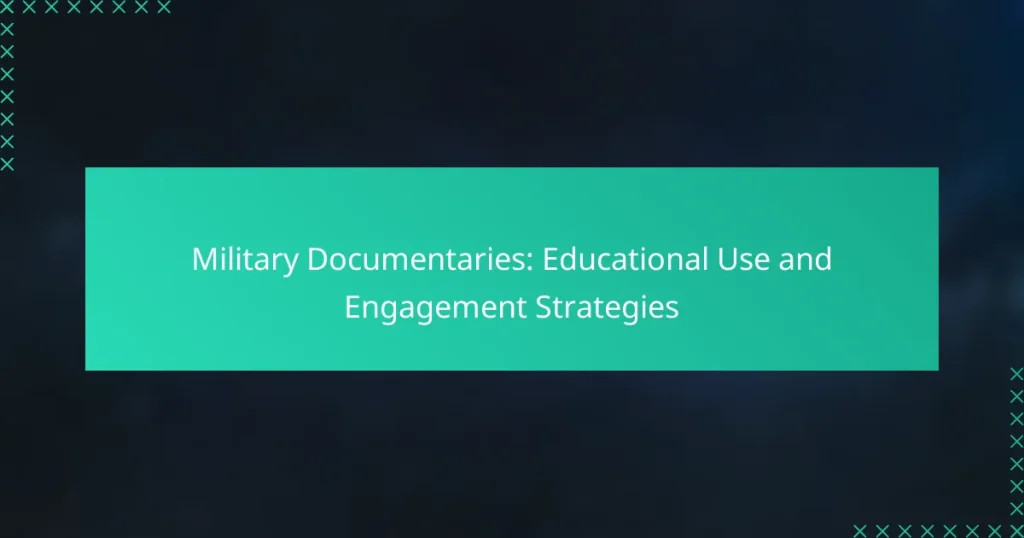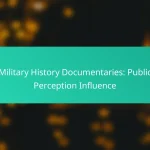Military documentaries serve as powerful educational tools by presenting engaging visual narratives that bring complex historical events and military strategies to life. By fostering critical thinking and discussion, these films make history more relatable and impactful for students. Implementing interactive engagement strategies can further enhance viewer understanding and retention, encouraging collaborative experiences and diverse media formats.
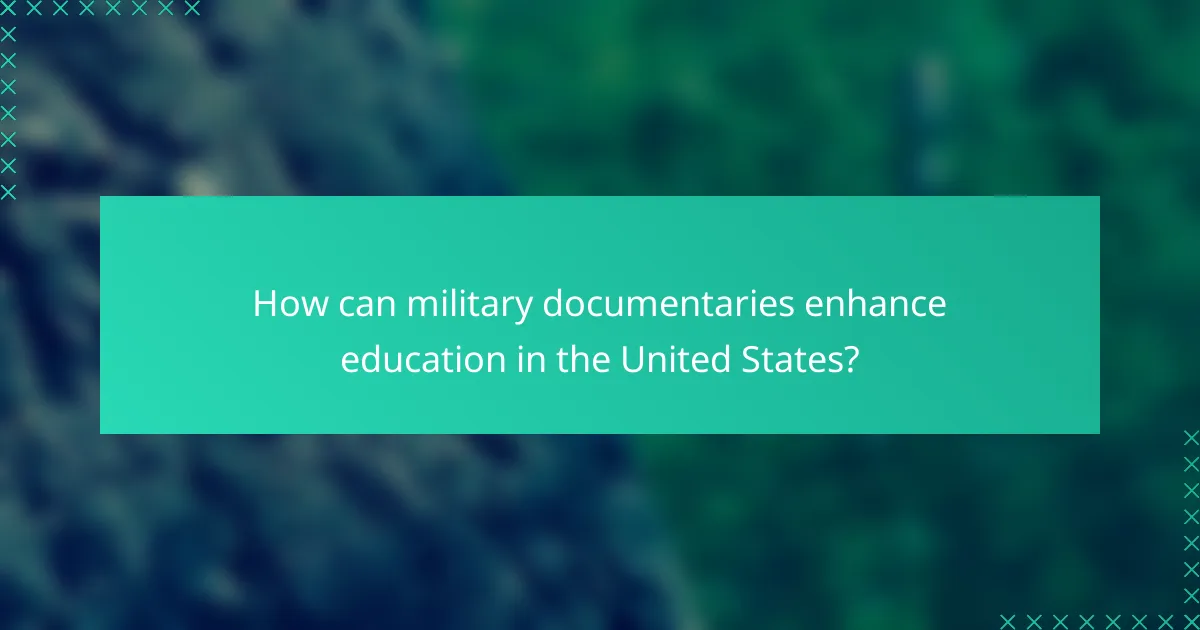
How can military documentaries enhance education in the United States?
Military documentaries can significantly enhance education in the United States by providing engaging, visual narratives that illustrate complex historical events and military strategies. These films foster critical thinking and discussion among students, making history more relatable and impactful.
Engaging storytelling techniques
Military documentaries often utilize compelling storytelling techniques that draw viewers into the narrative. By combining personal accounts, dramatic reenactments, and expert interviews, these films create an immersive experience that captivates audiences. This approach not only holds attention but also encourages deeper emotional connections to historical events.
For instance, documentaries like “The Vietnam War” by Ken Burns use a mix of archival footage and personal stories, making the historical context more vivid and relatable. Educators can leverage these techniques to enhance classroom discussions and encourage students to analyze the narrative structure and its impact on understanding history.
Historical context and analysis
Military documentaries provide valuable historical context that aids in the analysis of past conflicts and their implications. By presenting events within their broader socio-political framework, these films help students grasp the complexities of military decisions and their consequences. This context is essential for understanding not just what happened, but why it mattered.
Educators can use documentaries to prompt discussions about the causes and effects of wars, the evolution of military tactics, and the ethical considerations involved. For example, analyzing the motivations behind World War II can lead to critical discussions about nationalism and global politics.
Interactive learning experiences
Incorporating military documentaries into the classroom can create interactive learning experiences that engage students beyond traditional lectures. Teachers can facilitate group projects where students create presentations based on documentary content, encouraging collaboration and critical thinking.
Additionally, educators might consider using documentary screenings followed by guided discussions or debates. This method allows students to express their viewpoints and analyze different perspectives, fostering a more dynamic learning environment. Using platforms that allow for interactive viewing, such as quizzes or discussion forums, can further enhance engagement and retention of information.

What are effective engagement strategies for military documentaries?
Effective engagement strategies for military documentaries include interactive elements that enhance viewer understanding and retention. These strategies foster discussion, utilize diverse media formats, and encourage collaborative viewing experiences.
Incorporating discussion forums
Discussion forums can significantly enhance engagement by allowing viewers to share insights and perspectives on military documentaries. These platforms can be hosted online or in-person, providing a space for participants to ask questions and debate themes presented in the films.
To implement this, consider creating a dedicated forum on social media or a learning management system. Encourage participants to post their thoughts after viewing, and facilitate guided discussions to deepen understanding of complex topics.
Utilizing multimedia resources
Incorporating multimedia resources, such as maps, infographics, and interviews, can enrich the viewing experience of military documentaries. These resources provide context and visual aids that help explain intricate military strategies and historical events.
For example, pairing a documentary with interactive maps that show troop movements or timelines can help viewers visualize the content better. Additionally, using supplementary videos featuring expert commentary can clarify and expand on the documentary’s themes.
Facilitating group viewings
Group viewings create a communal atmosphere that can enhance engagement with military documentaries. Watching together allows for immediate discussion and collective reflection, which can lead to deeper insights and shared learning experiences.
To organize a successful group viewing, select a comfortable venue and provide discussion prompts to guide post-viewing conversations. Consider scheduling a Q&A session with a knowledgeable guest speaker to further enrich the experience and provide expert perspectives on the documentary’s content.

Which military documentaries are most impactful for educational purposes?
Impactful military documentaries provide deep insights into historical events, fostering understanding and engagement. They often combine personal narratives with factual accounts, making complex topics accessible and relatable for viewers.
Ken Burns’ “The Vietnam War”
Ken Burns’ “The Vietnam War” is a comprehensive documentary that explores the multifaceted aspects of the Vietnam conflict through interviews, archival footage, and personal stories. Its in-depth analysis encourages critical thinking about the war’s impact on American society and its veterans.
Educators can use this documentary to facilitate discussions on topics such as media influence, political decisions, and the human cost of war. It is particularly effective for high school and college students studying history, sociology, or political science.
“Restrepo” by Sebastian Junger
“Restrepo,” directed by Sebastian Junger, follows a platoon of U.S. soldiers deployed in Afghanistan, offering an unfiltered look at their experiences in combat. This documentary emphasizes the emotional and psychological challenges faced by soldiers, making it a powerful tool for understanding modern warfare.
Using “Restrepo” in educational settings can help students grasp the realities of military life and the complexities of foreign conflicts. It is suitable for discussions on ethics, military strategy, and the effects of war on mental health.
“They Shall Not Grow Old” by Peter Jackson
Peter Jackson’s “They Shall Not Grow Old” presents World War I through restored archival footage, enhanced with sound and color to bring history to life. This documentary provides a unique perspective on the soldiers’ experiences, highlighting their humanity amidst the horrors of war.
Incorporating this film into the classroom can spark interest in World War I and encourage students to explore themes of memory, history, and the evolution of warfare. It is particularly impactful for visual learners and those interested in film studies.
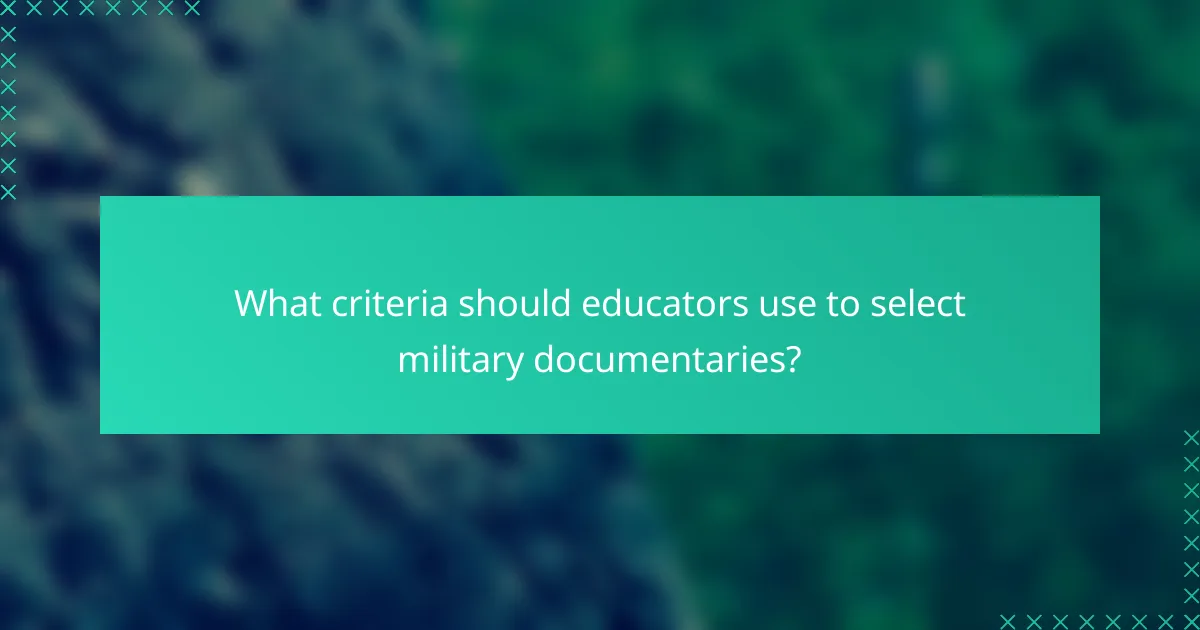
What criteria should educators use to select military documentaries?
Educators should consider relevance to curriculum standards, quality of production and accuracy, and viewer engagement potential when selecting military documentaries. These criteria ensure that the documentaries not only inform but also resonate with students, enhancing their learning experience.
Relevance to curriculum standards
Selecting military documentaries that align with curriculum standards is essential for effective teaching. Educators should review local educational guidelines to ensure that the content supports specific learning objectives and competencies. For example, documentaries that cover historical events relevant to a history curriculum can provide context and deepen understanding.
Additionally, educators can look for documentaries that incorporate interdisciplinary themes, such as ethics in warfare or the impact of military actions on society, which may align with social studies or civics standards. This approach fosters critical thinking and encourages students to make connections across subjects.
Quality of production and accuracy
The quality of production and accuracy of information are crucial factors in selecting military documentaries. High-quality documentaries typically feature well-researched content, credible sources, and professional filmmaking techniques. Educators should verify the credentials of the filmmakers and the accuracy of the information presented to avoid disseminating misinformation.
Documentaries that include interviews with experts, veterans, or historians can enhance credibility. Educators can also check reviews or ratings from reliable sources to gauge the documentary’s reception and educational value before incorporating it into their lessons.
Viewer engagement potential
Engagement is key to maintaining student interest and facilitating learning. Educators should select military documentaries that employ compelling storytelling, dynamic visuals, and relatable narratives. Documentaries that include personal stories or firsthand accounts often resonate more with students, making the content more impactful.
To assess engagement potential, educators can preview the documentary and consider its pacing, emotional appeal, and interactive elements, such as discussion prompts or accompanying materials. Incorporating documentaries that encourage critical discussions or reflections can further enhance student involvement and understanding of military topics.
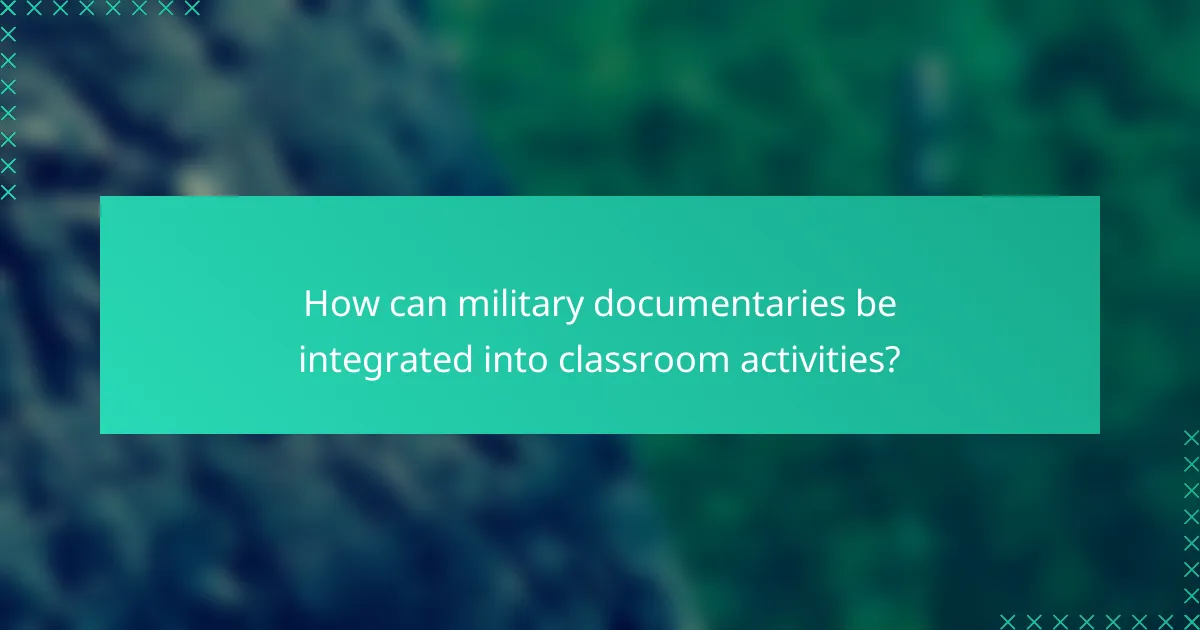
How can military documentaries be integrated into classroom activities?
Military documentaries can be effectively integrated into classroom activities by using them as a foundation for lesson plans, discussions, and assignments that promote engagement and critical thinking. These films provide real-world context and stimulate interest in historical and contemporary military issues.
Creating lesson plans around documentaries
When creating lesson plans centered on military documentaries, start by selecting films that align with your curriculum objectives. For example, if teaching about World War II, choose a documentary that covers key battles or strategies. Incorporate pre-viewing questions to set the stage and post-viewing activities to reinforce learning.
Consider using a mix of multimedia resources, such as maps or primary source documents, alongside the documentary to enhance understanding. This approach can help students make connections between the film content and historical events.
Encouraging critical thinking discussions
Facilitate critical thinking discussions by posing open-ended questions related to the documentary’s themes, such as the ethical implications of military decisions or the impact of war on society. Encourage students to express their opinions and support them with evidence from the film.
Utilize small group discussions to allow students to explore different perspectives before sharing with the larger class. This method fosters a collaborative learning environment and helps students develop their analytical skills.
Assigning reflective essays
Assign reflective essays that require students to analyze the documentary’s content and relate it to broader themes in military history or ethics. Prompt students to consider how the documentary’s portrayal of events influences their understanding of military conflicts.
Provide clear guidelines for the essays, including length, format, and key questions to address. Encourage students to incorporate personal reflections and insights, which can deepen their engagement with the material and enhance their critical writing skills.
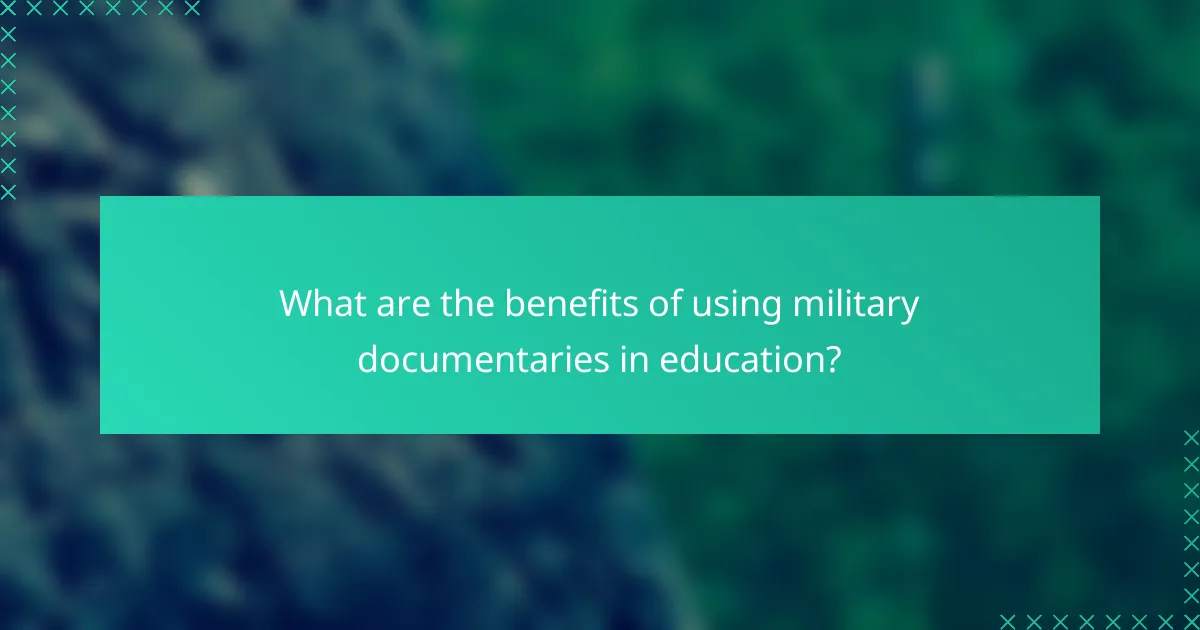
What are the benefits of using military documentaries in education?
Military documentaries offer numerous educational benefits, including the enhancement of historical knowledge and the development of empathy towards diverse perspectives. These films serve as powerful tools for engaging students with real-life events, fostering critical thinking and discussion.
Improved historical understanding
Military documentaries provide a vivid portrayal of historical events, allowing students to grasp complex narratives and timelines. By presenting firsthand accounts and archival footage, these films can make history more relatable and tangible.
For instance, documentaries focusing on major conflicts, such as World War II or the Vietnam War, can illustrate the socio-political contexts that shaped these events. Educators can use these resources to supplement traditional textbooks, offering a multi-dimensional view of history.
Enhanced empathy and perspective
Viewing military documentaries can cultivate empathy by showcasing the human experiences behind warfare. Students are exposed to the personal stories of soldiers, civilians, and families affected by conflict, which can deepen their understanding of the emotional and psychological impacts of war.
To maximize this benefit, educators can facilitate discussions around the themes presented in the documentaries, encouraging students to reflect on the moral implications of war and the diverse perspectives involved. This approach not only enriches their learning experience but also promotes critical thinking and compassion.
